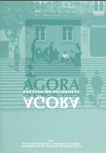Kierkegaard’s Form of Writing and Use of Socrates in “At a Graveside”
Contenido principal del artículo
Resumen
Este artículo examina el discurso de Kierkegaard “Junto a una tumba” de Tres discursos sobre ocasiones imaginarias. Se argumenta que este texto ilustra la manera especial de Kierkegaard de presentar sus ideas. El discurso es interdisciplinario, con elementos de literatura, filosofía y teología. Pero esto no quiere decir que sea una obra literaria, filosófica o teológica. Más bien, es una combinación de todas ellas que desafía la categorización en los géneros convencionales. Además, se argumenta que una parte importante de la forma de escribir de Kierkegaard en “Junto a la tumba” está relacionada con su conocida emulación de Sócrates.
Palabras clave:
Detalles del artículo
Referencias
Amir, Lydia B., “Individual,” in S.M. Emmanuel, W. McDonald and J. Stewart (eds.), Kierkegaard’s Concepts, Tome IV, Individual to Novel, Farnham and Burlington, Ashgate, 2014 (Kierkegaard Research: Sources, Reception and Resources, vol. 15), pp. 1-7.
Barrett, Lee C. (ed.), Kierkegaard as Theologian, London, Bloomsbury, 2018.
Barrett, William, Irrational Man, Garden City, New York, Doubleday Anchor Books, 1962.
Davenport, John, “Earnestness,” in S.M. Emmanuel, W. McDonald and J. Stewart (eds.), Kierkegaard’s Concepts, Tome II, Classicism to Enthusiasm, Aldershot, Ashgate, 2014 (Kierkegaard Research: Sources, Reception and Resources, vol. 15), pp. 219-227.
Farber, Marvin, Phenomenology and Existence: Toward a Philosophy within Nature, New York, Evanston and London, Harper & Row, 1967.
Hannay, Alastair, “Kierkegaard and What We Mean by ‘Philosophy’”, International Journal of Philosophical Studies, vol. 8, no. 1 (2000), pp. 1-22.
Hannay, Alastair, “Kierkegaard’s Single Individual and the Point of Indirect Communication,” in Steven Crowell (ed.), The Cambridge Companion to Existentialism, Cambridge, Cambridge University Press, 2012, pp. 73-95.
Hannay, Alastair, “Why Should Anyone Call Kierkegaard a Philosopher?” in N.J. Cappelørn and J. Stewart (eds.), Kierkegaard Revisited, Berlin and New York, Walter de Gruyter, 1997 (Kierkegaard Studies Monograph Series, vol. 1), pp. 238-253.
Henriksen, Aage, Kierkegaards Romaner, Copenhagen, Gyldendal, 1954.
Himmelstrup, Jens, Søren Kierkegaards Opfattelse af Sokrates. En Studie i dansk Filosofis Historie, Copenhagen, Arnold Busck, 1924.
Howland, Jacob, Kierkegaard and Socrates: A Study in Philosophy and Faith, New York, Cambridge University Press, 2006.
[Jean Paul], Jean Paul’s sämmtliche Werke, vols. 1-60, Berlin, G. Reimer, 1826-28.
[Kierkegaard, Søren], Søren Kierkegaards Skrifter, vols. 1-28, K1-K28, ed. by Niels Jørgen Cappelørn, Joakim Garff, Jette Knudsen, Johnny Kondrup and Alastair McKinnon, Copenhagen, Gad Publishers, 1997-2012.
Kierkegaard, Søren, The Moment and Late Writings, trans. by Howard V. Hong and Edna H. Hong, Princeton, Princeton University Press, 1998.
Kierkegaard, Søren, The Point of View, trans. by Howard V. Hong and Edna H. Hong, Princeton, Princeton University Press, 1998.
Kierkegaard, Søren, Three Discourses on Imagined Occasions, trans. by Howard V. Hong and Edna H. Hong, Princeton, Princeton University Press, 1993.
Kierkegaard, Søren, Tre Taler ved tænkte Leiligheder, Copenhagen, C.A. Reitzel, 1845.
Kirkconnell, W. Glenn, “Earnestness or Estheticism: Post 9/11 Reflections on Kierkegaard’s Two Views of Death,” Florida Philosophical Review, vol. 3 (2003), pp. 62-72.
Kloeden, Wolfdietrich von, Kierkegaard und Sokrates. Sören Kierkegaards Sokratesrezeption, Rheinland-Westfalen-Lippe, Evangelische Fachhochschule, 1991 (Schriftenreihe der Evangelischen Fachhochschule Rheinland-Westafalen-Lippe, vol. 16).
Mjaaland, Marius G., “Death and Aporia: Some Reflections on the Problem of Thinking Death in At a Graveside (1845),” Kierkegaard Studies Yearbook (2003), pp. 395-418.
Muench, Paul, “Kierkegaard’s Socratic Pseudonym: A Profile of Johannes Climacus,” in R.A. Furtak (eds.), Kierkegaard’s Concluding Unscientific Postscript: A Critical Guide, Cambridge, Cambridge University Press, 2010, pp. 25-44.
Muench, Paul, “The Socratic Method of Kierkegaard’s Pseudonym Johannes Climacus: Indirect Communication and the Art of ‘Taking Away,’” in P. Houe and G.D. Marino (eds.), Kierkegaard and the Word(s): Essays on Hermeneutics and Communication, Copenhagen, C.A. Reitzel, 2003, pp. 139-50.
Nun, Katalin, Gerhard Schreiber and Jon Stewart (eds.), The Auction Catalogue of Kierkegaard’s Library, Farnham and Burlington, Ashgate, 2015 (Kierkegaard Research: Sources, Reception and Resources, vol. 20).
Schulz, Heiko, Aneignung und Reflexion, vol. 2, Studien zur Philosophie und Theologie Søren Kierkegaards, Berlin and Boston, De Gruyter, 2014 (Kierkegaard Studies Monograph Series, vol. 28).
Scopetea, Sophia, Kierkegaard og græciteten. En kamp med ironi, Copenhagen, C.A. Reitzel, 1995.
Stewart, Jon and Katalin Nun (eds.), Kierkegaard and the Greek World, Tome I, Socrates and Plato, Aldershot, Ashgate, 2010 (Kierkegaard Research: Sources, Reception and Resources, vol. 2).
Stewart, Jon, “Borges on Immortality,” Philosophy and Literature, vol. 17, no. 2 (1993), pp. 78-82.
Stewart, Jon, Idealism and Existentialism: Hegel and Nineteenth- and Twentieth-Century European Philosophy, New York and London, Continuum International Publishing, 2010.
Stewart, Jon, Kierkegaard’s Relations to Hegel Reconsidered, New York, Cambridge University Press, 2003.
Stewart, Jon, Søren Kierkegaard: Subjectivity, Irony and the Crisis of Modernity, Oxford, Oxford University Press, 2015.
Stewart, Jon, The Unity of Content and Form in Philosophical Writing: The Perils of Conformity, London, New Delhi, New York and Sydney, Bloomsbury, 2013.
Stokes, Patrick and Adam J. Buben (eds.), Kierkegaard and Death, Bloomington and Indianapolis, Indiana University Press, 2011.
Theunissen, Michael, “Das Erbauliche im Gedanken an den Tod. Traditionale Elemente, innovative Ideen und unausgeschöpfte Potentiale in Kierkegaards Rede. An einem Grabe,” Kierkegaard Studies Yearbook (2000), pp. 40-73.
Theunissen, Michael, “The Upbuilding in the Thought of Death: Traditional Elements, Innovative Ideas, and Unexhausted Possibilities in Kierkegaard’s Discourse ‘At a Graveside,’” in R.L. Perkins (ed.), “Prefaces” and “Writing Sampler” / “Three Discourses on Imagined Occasions”, Macon, Georgia, Mercer University Press, 2006 (International Kierkegaard Commentary, vols. 9-10). pp. 321-358.)
Theunissen, Michael, Der Begriff Ernst bei Søren Kierkegaard, Freiburg i. Br. and Munich, Alber, 1958.
Thulstrup, Marie Mikulová, “The Single Individual,” in M.M. Thulstrup (ed.), Some of Kierkegaard’s Main Categories, Copenhagen, C.A. Reitzel, 1988 (Bibliotheca Kierkegaardiana, vol. 16), pp. 9-25.
Widenmann, Robert J., “Christian Earnestness (Seriousness),” in M.M. Thulstrup (ed.), The Sources and Depths of Faith in Kierkegaard, Copenhagen, C.A. Reitzel, 1978 (Bibliotheca Kierkegaardiana, vol. 2), pp. 83-99.







